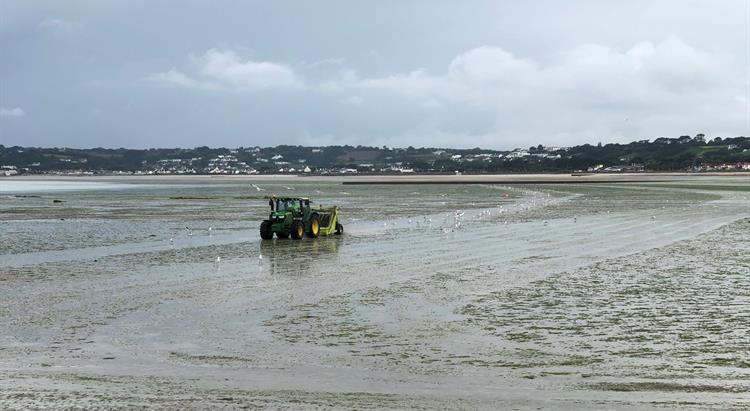13 August 2020

Infrastructure staff have come up with a new plan for removing the large amounts of sea lettuce that have accumulated in St Aubin’s Bay since temperatures rose to consistently high levels.
Until now, the landing craft used to transport sea lettuce out to an approved dumping ground at sea needed spring tides to approach the shore and pick up the seaweed. This limited the times it was possible to do the work, and meant it was only possible to transport one load per day.
However, from the Friday a new approach is being trialled. The landing craft, Normandy Trader, will moor at the old lifeboat slipway in St Helier harbour and contractors will remove the sea lettuce, load it onto trucks and transport it there by road. It will then be loaded onto the landing craft and taken out to sea. This means the work can start this week, during a period of neap tides, and the craft can make at least two trips per day. This will increase the amount of sea lettuce that can be taken from the beach each day and will remove the limitations of working around the tides.
Assistant Manager for the department, Bob Major, who came up with the idea, said: “We’ve tried a number of different methods of clearing sea lettuce from the beach and we always consider any new ideas that are brought to us. The department wants to sort out this problem and safeguard Islanders, and this new trial will mean we aren’t reliant on the tides to do the work.
“We will be working on the beach from early on Friday morning to get the seaweed removed, and if this works Islanders will soon see a real difference along the bay.”
The department will also be harvesting clean green sea lettuce with their Surf-Rake, for spreading on available farmland. This would be subject to environmental restrictions and is also a trial. The heavy deposits scraped up by contractors’ machinery cannot be dealt with in this way as they are contaminated by too much sand and stones.
Infrastructure Minister, Deputy Kevin Lewis, said: “Sea lettuce is a difficult problem that we have been tackling for many years. This plan will make a real difference to the beach, as we will be able to use the landing craft consistently, regardless of tides. Each full load takes approximately 80 tons and if Friday’s trial is successful the contractors will work throughout the weekend to load up the landing craft and clear the beach.
“I would like to thank Bob Major for coming up with this idea, and we can hopefully spread another 500 tons of clean sea lettuce on agricultural land.”
Background
The growth of sea lettuce depends on many factors, including nutrient availability, sunlight and temperature. Sea lettuce is more prolific some years than others, which is thought to be linked to higher sea temperatures in the spring and increased nutrient availability (from heavy rainfall) over the winter.
Infrastructure staff have been removing the sea lettuce for composting at a rate of 80 tonne per week, which is the maximum capacity of La Collette green waste. This process removed 141.76 tonne in June and 186.3 tonne in July.